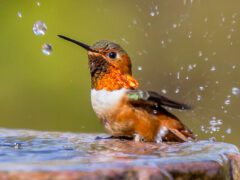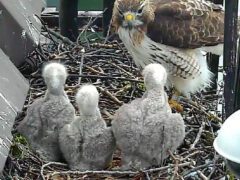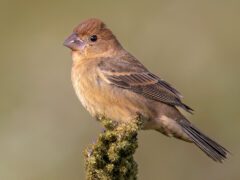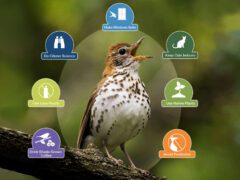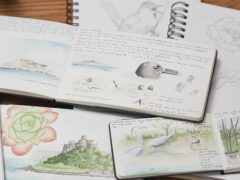Bay-breasted Warbler Photo Gallery
Breeding male
A long-winged warbler with thick, white wingbars. This breeding male shows a dark-streaked back, butter yellow neck patch, black mask, and a rich dark bay color on the crown, throat, and flanks. Generally found in trees, preferring conifers during the breeding season, but may be found on the ground during migration.
© Keenan Yakola / Macaulay LibraryMaine, May 14, 2016Breeding female
This long-winged, short-tailed warbler shows bold white wingbars and a dark-streaked back. Females are more subtly patterned than males. Note the color of the lower flank and undertail coverts: buff instead of white. This particularly drab individual has just a hint of bay color below the cheek.
© Ian Davies / Macaulay LibraryQuebec, May 28, 2018Breeding female
The stout bill, prominent pale neck patches, and bold white wingbars are useful for ID in all plumages. Breeding females show a variable amount of bay or chestnut on the crown, face, upper chest, and flank.
© Ian Davies / Macaulay LibraryQuebec, May 28, 2018Nonbreeding female/immature
Fall migrant females and immatures often show only faint bay or chestnut coloration, so instead focus on the bright yellow-green head and back, plain face lacking a strongly contrasting eyeline, bold white wingbars, and buff-olive (not white) undertail coverts. Additionally, the legs and feet are nondescript and dark, lacking strongly contrasting yellow soles to the feet.
© Peter Hawrylyshyn / Macaulay LibraryOntario, September 09, 2020Nonbreeding male
The stout, dark bill variably marked pale and the bold contrast created by the thick white wingbars against the dark gray wing are useful keys to identifying this messy-looking, nonbreeding male. The pale yellowish neck patch and bold swath of bay on the flank help to lock down the species ID.
© Ian Davies / Macaulay LibraryPanamá, March 17, 2009Nonbreeding female/immature
In late summer and fall, females and immatures are best identified by the low contrast yellow-green head, bold white wingbars, and plain, buff flanks and undertail coverts. Many also show a large amount of pale pink in the otherwise dark bill.
© Alix d'Entremont / Macaulay LibraryNova Scotia, August 24, 2016Nonbreeding female/immature
Nonbreeding individuals can be hard to identify. When viewed from below, look for plain, unstreaked yellow-green plumage with buff-olive tones on the flanks and undertail coverts. Also, the largely pale bill and low contrast face pattern with just a slight dark eyeline are subtly distinctive.
© ryan doherty / Macaulay LibraryMassachusetts, September 21, 2016Breeding male
The combination of a yellowish neck patch, black mask, and dark chestnut crown, throat, and flanks make the breeding male nearly unmistakable.
© Shailesh Pinto / Macaulay LibraryOhio, May 15, 2016Breeding male
Breeds in boreal spruce and fir forests. Though the black mask, yellowish neck patch, and chestnut throat and flanks create a very distinctive look for this breeding male, also note the buff tones of the undertail coverts and black-and-white tail pattern - these features are useful for ID in all plumages.
© Daniel Jauvin / Macaulay LibraryQuebec, June 01, 2017Compare with Similar Species
Click on an image to compare
Species in This Family
New World Warblers(Order: Passeriformes, Family: Parulidae)
Don't miss a thing! Join our email list
The Cornell Lab will send you updates about birds,
birding, and opportunities to help bird conservation.




















































